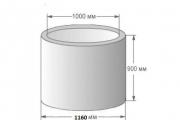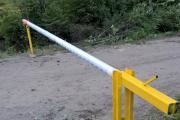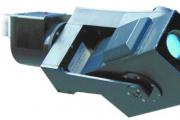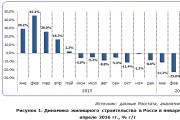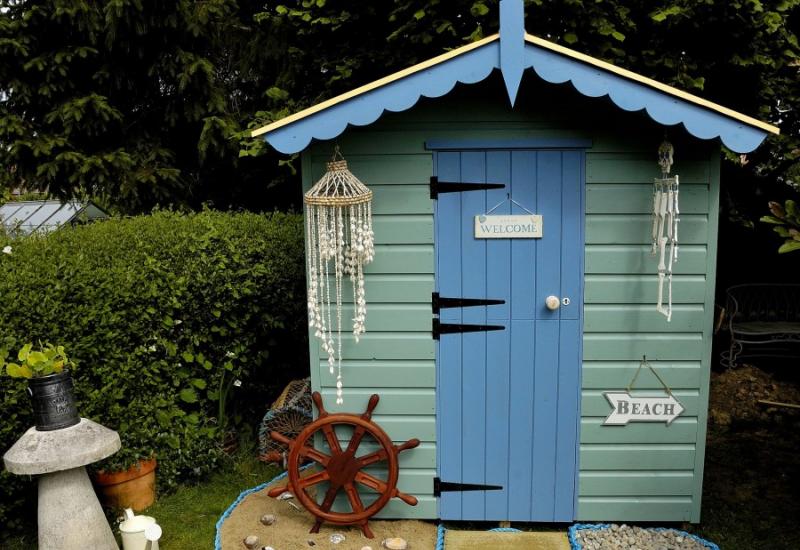Individual heat meter in the apartment. Individual metering of heat energy consumption
The decision to install a heating meter in an apartment is quite reasonable, aimed at reducing the cost of heating a home. With their help, costs will be significantly reduced, because the norm of the amount of thermal energy provided to each tenant is the same for everyone, and does not depend on the area of \u200b\u200bthe apartment.
Before you put meters on water heating in an apartment, you should find out if such an operation is feasible. The answer in each case is individual and depends on how the heating system is arranged.
There are 3 options in total:
- horizontal wiring;
- two-pipe vertical;
- single pipe vertical.
Is it possible to supply metered heating in each of these cases?
Vertical wiring
In most old houses built before the mid-90s, vertical wiring is most common: when several risers pass through the apartment, from which hot water enters the batteries. Since there are several risers, the installation of meters in this case is impossible: it is impossible to determine the amount of heating consumed.
Usually, in such situations, a common meter is installed for the whole house, but for this you will have to obtain the consent of all residents. Another option - installing equipment on all batteries - will be very expensive.
General house counter
If all residents of the house agree to pay the costs of installing a common measuring device for the house, the approval process begins.
It consists of:
- Meetings of all apartment owners, obtaining their written consent.
- Discussing the details: choosing a person who will be responsible for the progress of the work, and subsequently take the readings and distribute the payment to all tenants.
The measuring device is mounted either on the central pipe, through which heat enters the house, or on the return pipe, which removes the spent coolant from the residential building.
The experience of the residents who carried out this procedure shows that often the heat supplier ignores the norms prescribed in the contract, and with the help of the court, part of the wasted funds can be returned.
It is also not uncommon for situations when the installation of meters helped to significantly reduce heating costs.
Horizontal wiring
In new-built houses, horizontal wiring prevails - in each apartment there is only one riser, to which all batteries are connected. And here the installation of meters for heating in the apartment is allowed.
How profitable is it to install measuring equipment?
Here, too, not everything is clear. The cost of heat energy depends on many factors: the area of the apartment, the general condition of the house, the quality of its insulation, the presence of double-glazed windows and others.
Benefits of installing a meter
Thanks to a measuring device installed in accordance with all standards, you can reduce costs:
- In case of temporary absence: by turning off the heat supply to your apartment upon departure. So the amount of heat carrier consumed will be zero, but you will still need to pay your share for heating common areas (stairwell, entrance, attic, and others).
- Independently adjusting the temperature level in the room. Almost every modern battery is equipped with an individual thermostat, with which you can reduce or increase the supply of coolant to a specific heating element. During periods of warming or during a long absence, you can reduce the level of heat energy consumption, thereby reducing costs.
- With high-quality insulation of houses and apartments. If the wall of the apartment facing the street is sheathed with heat-insulating material, the heat loss will be small, and therefore there will be no need to use the coolant at full capacity.
How to install such a counter?
In order to complete the installation in accordance with all the rules, you must:
- Contact the management company and get permission for the procedure. To do this, you will also need to attach to the application a technical passport of the apartment, documents proving the ownership of it. In some cases, the consent of all neighbors may also be required.
- Wait for the response of the management company, and in case of a positive decision, obtain technical conditions.
- Apply for the development of the project to a specialized company licensed to provide such services, and entrust it with the collection of the necessary documents.
- Submit the collected package of documents for approval.
- Get permission.
- Order the installation of the company's measuring devices according to the developed project.
- Draw up an agreement with a company supplying coolant to the house. Develop and agree on the terms of payment for heat energy.
- Let a representative of the company into the apartment so that he puts seals.
After successfully solving all these problems, the owner of the apartment pays for heating according to the meter readings.
Obtaining permission and the process of installing measuring equipment in a private house is the same as installing heating meters in an apartment.
Why is it impossible to install the counter with your own hands?
It is impossible to install measuring equipment on your own for 2 main reasons:
- By law, only companies that have the appropriate license have the right to carry out work. It can only be obtained by specialists who have confirmed their skills in working with measuring equipment and have passed various checks.
- It is impossible for a non-professional to take into account all the nuances of installation. Incorrectly installed measuring equipment can distort the data.
Which counter is better?
measuring devices used in residential premises can be:
- tachometric;
- waybills;
- ultrasonic.
Tachometric
Devices of this type carry out measurements using an impeller - this part is immersed in a pipe through which the coolant passes. The readings of the sensors installed in the supply and discharge pipelines are compared, thus determining the temperature difference. With the information received the electronic unit The device calculates the amount of consumed heat energy.
Mechanical meters are the least complex and therefore the least expensive. The downside is that the veracity of their testimony is highly dependent on the purity of the coolant.
It is important to know! Heat suppliers do not always agree to conclude an agreement with the owner of this type of meter: in addition to a high percentage of false readings, these devices are simple in design. Thanks to this, some consumers easily adjust the readings in their favor.
Ultrasonic
Ultrasonic, on the other hand, are more accurate and have a longer service life. They do not affect the movement of the coolant in any way. This type includes a line of Russian-made Avektra heat meters. Of the advantages of this counter, one can single out the build quality and ease of installation. However, despite their accuracy, such devices are also capable of giving false readings. This happens if the hot water supplied to the batteries is too heavily polluted.
The principle of operation of such devices is based on determining the flow rate of the coolant using ultrasound passing through the working section.
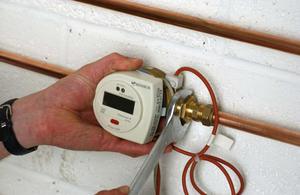 The average cost of this type of meter exceeds the price of mechanical counterparts by approximately 20%.
The average cost of this type of meter exceeds the price of mechanical counterparts by approximately 20%.
Since measuring ultrasonic devices are quite complex in design and do not tolerate outside interference, heat supply companies recommend using them.
Overhead
Sensors mounted on the battery itself determine the air temperature in the room and the surface temperature of the heater. After receiving these data, the device block determines the amount of consumed heat energy, taking into account the radiator power data (these values \u200b\u200bare to be entered by the owner himself).
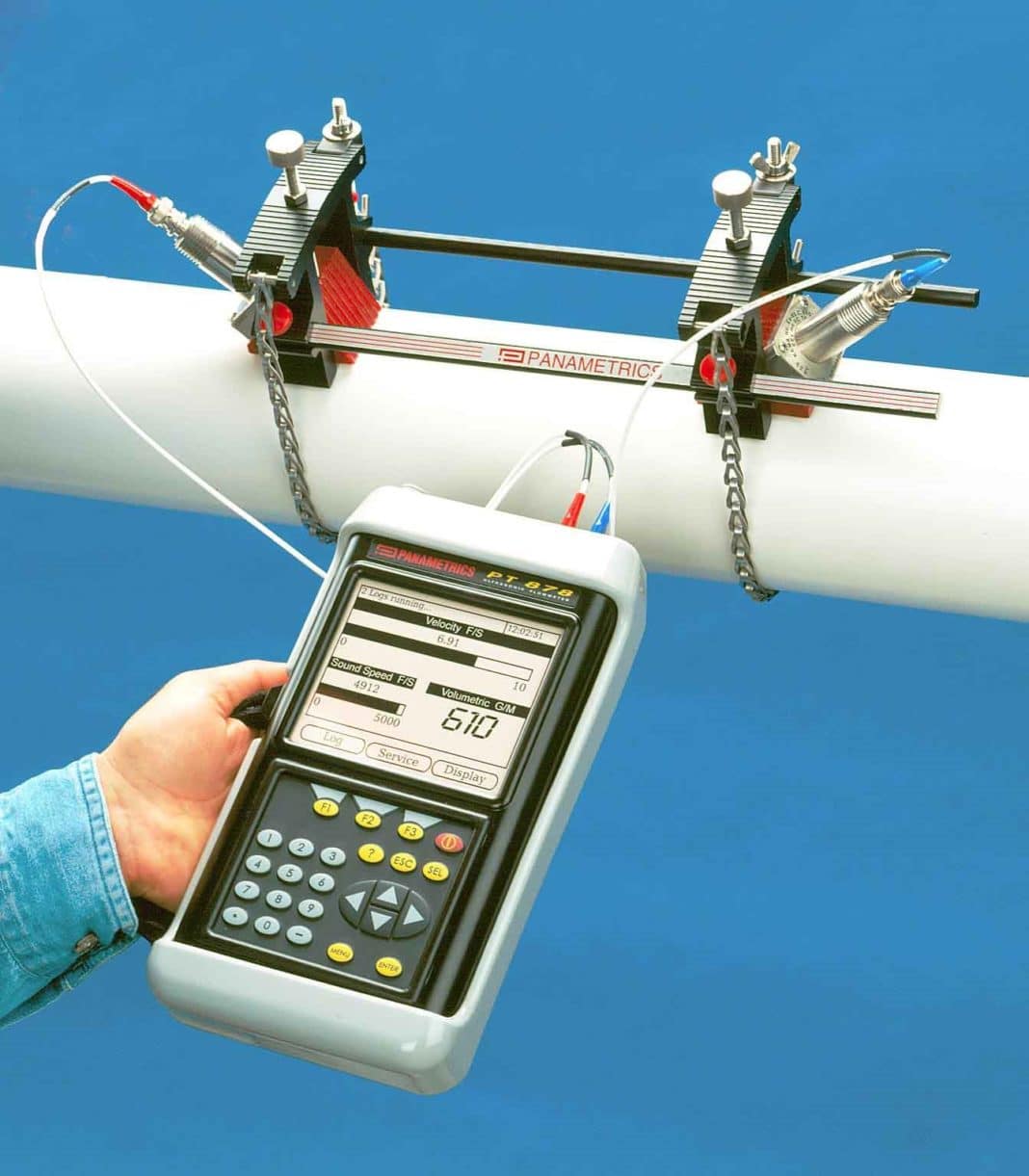 The readings of such devices are not accepted by the heat supplier.
The readings of such devices are not accepted by the heat supplier.
What else is useful to know before installing measuring instruments?
- In order to justify the cost of installing the measuring device, before installation it is desirable to insulate the walls facing the street with high quality, install plastic windows or perform reliable thermal insulation of wooden frames and the front door.
- It is also advisable to replace old batteries with modern radiators equipped with inlet and outlet valves. With their help, the owner can increase and decrease the amount of coolant consumed, temporarily turn off the tap completely (during a long absence, for example).
- In order for the meter readings to be true, it is also desirable to install a special filter on the inlet pipe section in front of the measuring device. He will cleanse hot water from large fractions present in it, which significantly affect the accuracy of measurements.
- You should not purchase a measuring device, guided only by its low cost. A high-quality and accurate device cannot be cheap, it is important to study all the parameters of the equipment and find out the opinion of customers about it.
The process of installing a heating meter is a procedure that will require a lot of patience from the owner of the apartment, because he will first have to obtain permission from the management company of the house, collect a lot of documents, and then choose a company that will do the installation. However, as a result, if everything is done correctly, the work will pay off - the cost of heat energy will significantly decrease.
The article was prepared with the support of the online plumbing store in Novosibirsk Kvadrat-NSK
Since the heat meter appeared, many residents of apartments and private houses heated from the central system have decided to keep records of heat supply. The meter is mounted directly on the pipe. It produces real measurements of the consumed heat. In this case, it even makes sense to install thermostats that will regulate the flow of hot coolant. Together, this will reduce heating costs. This article will discuss how to install a heat meter so that it complies with the legislation of the Russian Federation.
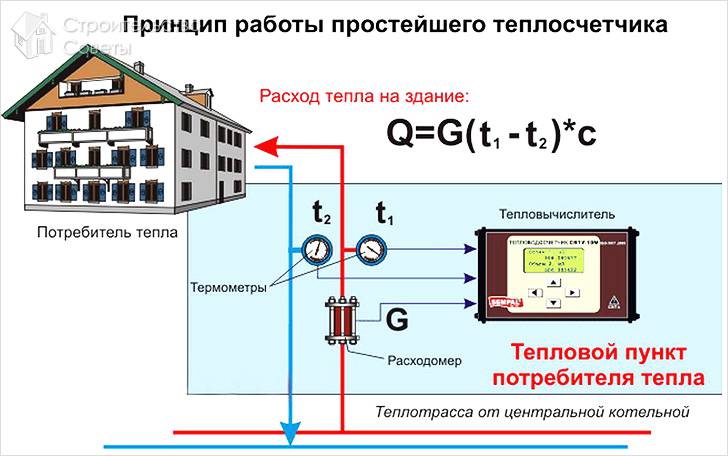
The heat meter makes measurements based on the following data:
- Consumption of hot coolant, which is delivered to the heating system.
- Temperature at the inlet to the heating system.
- The temperature at the outlet of the heating system.
Based on the results of the operation of the device, a figure of heat consumption is obtained, which is measured in hectacalories - per year, month and day.
The advantage of modern devices is that they are able to store the necessary information, namely on heat consumption, up to 10 years. At the same time, information can be read from the Internet on a computer.
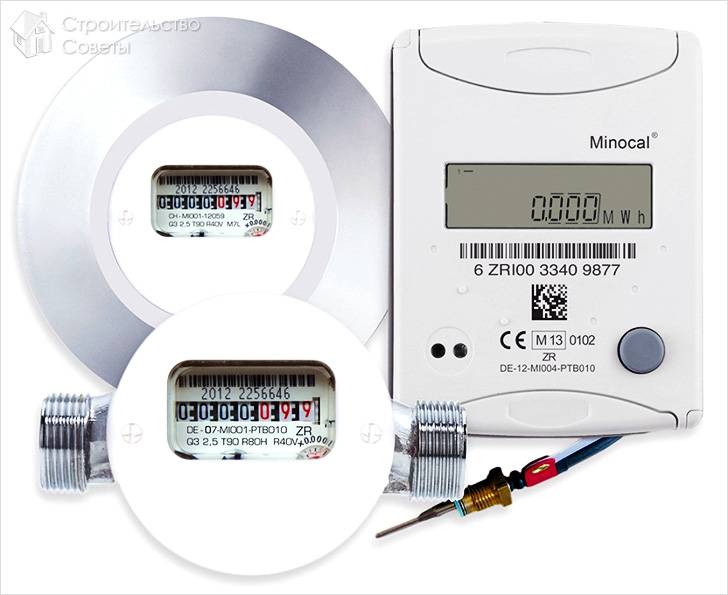
The unit you have chosen must be approved for operation in the Russian Federation. For this reason, it is better to give preference to a domestic manufacturer. To reduce the risk of measurement errors, when choosing, pay attention to the following nuances:
- Approximate consumption of thermal energy.
- Pipe diameter. The diameter of the place where the device will be mounted is especially important.
The prices of heat meters vary from 5,000 to 25,000 rubles. It all depends on the configuration and number of functions of a particular model.

There are several types of meters, determined by the flow meters that are installed on them:
- Mechanical. Such devices are distinguished by their unpretentiousness. But despite this, they are not recommended for use in cases where the water is too hard, there is scale and rust. Moreover, mechanical devices do not tolerate sudden changes in the consumption of thermal energy.
- Vortex. When installing such a unit, a magnetic mesh filter is necessarily mounted. This is due to the fact that the vortex counter is sensitive to poor quality welding and the presence of air in the pipes.
- Electromagnetic. If the wire connection is poor, then there may be large errors in the readings. Also, the readings are affected by the appearance of impurities in the coolant.
- Ultrasonic. They work great as long as the coolant is of good quality.
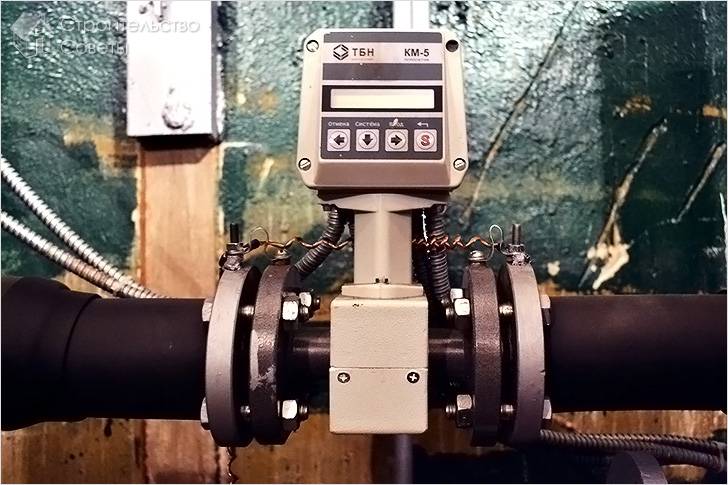
Before thinking about installing a heat meter, you should find out if it can be installed in your apartment. There are some conditions regarding this:
- If you use vertical piping, namely for each radiator a separate pipe riser going from bottom to top, then installing a heat meter is not rational. Otherwise, you will need to install several computing devices at once on each heating riser. Plus, you will create additional hydraulic resistance in the system. This will significantly affect the heating mode of the entire building.
- If the piping in an apartment or in a private house is horizontal, that is, when two supply / return pipes are installed and all radiators are connected through them, then the installation of a heat meter is even recommended.
The second case of installation completely eliminates the shortcomings of the first option.
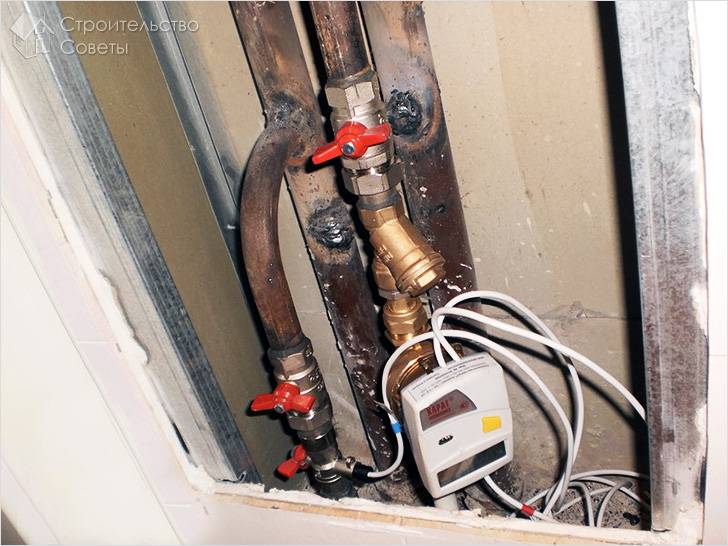
As for the installation steps, there are several successive steps:
- Installation of an automated heating unit.
- Balancing the heating system by risers.
- Equipping radiators with thermostats.
According to the calculations for the transition to apartment-by-apartment heat metering, the reconstruction of the heating system pays off within 2-4 years.
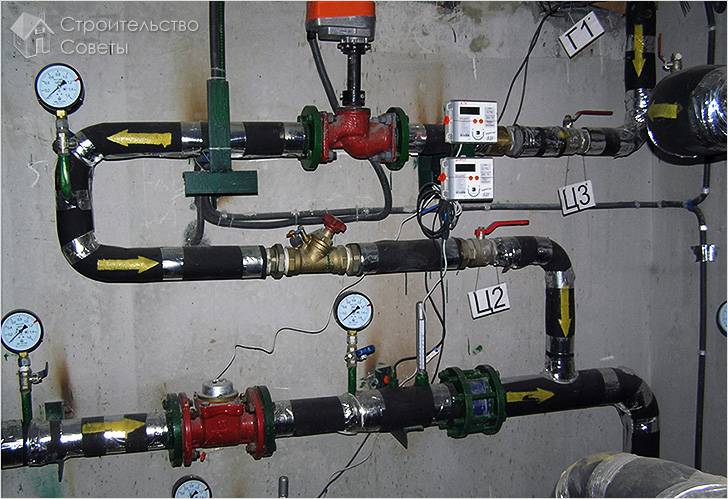
But before installing a thermal energy meter, it is imperative to fulfill some requirements. Otherwise, the installation will be illegal.
- First of all, all possible heat losses are eliminated. Only in this case, this device will allow you to save.
- Next, you need to get TU (technical conditions) from the management company, HOA or ZhEK. They will indicate what exactly is needed to implement the counter. As a rule, this includes an A4 sheet. It will be written on it what temperature and pressure the coolant passing through your apartment will have.
- On the basis of TS, you carry out an order for a project for installation. To do this, contact the design organization, which must have a license to carry out such work.
- As for the installation itself, it is also performed by a licensed company. When choosing one, make sure there are guarantees for the work being done. Is a free engineer visit included for a preliminary inspection? Does the installation include a full list of works (otherwise you will have to look for additional specialists to carry out one or another stage of work)? Are qualified personnel and specialized equipment available? Do you have all the documents, namely certificates, SRO approvals, certificates? Is there information about the selected company in the Unified State Register of Legal Entities?
- When installation work is completed, the meter is sealed and an act of acceptance is signed.
On average, the complex of services will cost about 20 thousand rubles. If the price bites, then you can do all the red tape with the documents yourself. You decide.
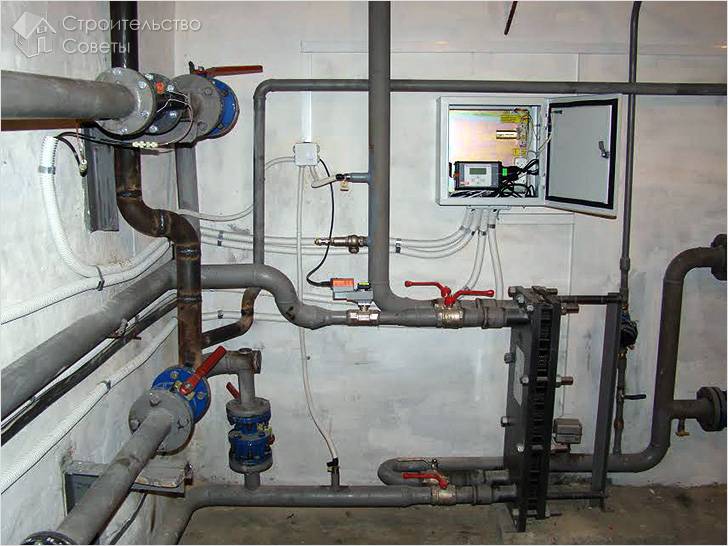
If we talk about the subsequent maintenance, then most licensed companies take care of this stage. At least this is taken into account when drafting the contract.
As for private houses, the installation of a heat meter in them is necessary only in cases where its heating is tied to the central heating system. The principle of operation of installing such a unit in a private house is identical to the process described for apartments. Please share your experience with this unit. It will be interesting for us and our readers to know whether the expected effect of installing a heat meter is noticeable.
Video
The material provided tells about the intricacies of introducing a heat meter into the heating system, as well as about the device of the unit itself:
Scheme
On the diagrams you can see all kinds of options for installing a heat meter:

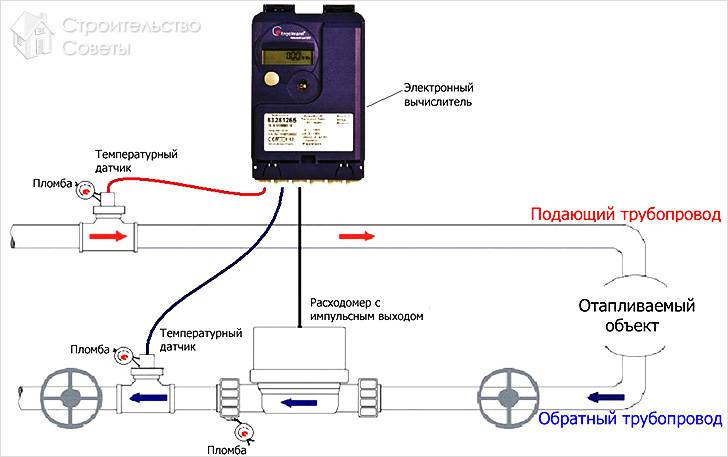
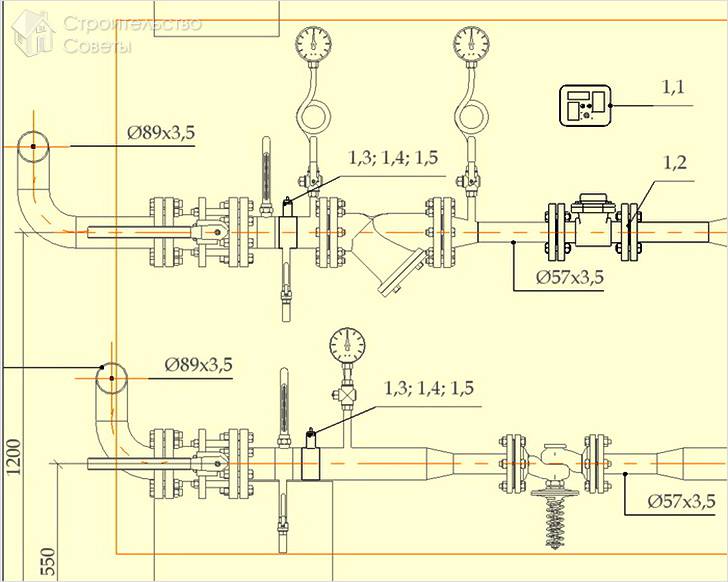
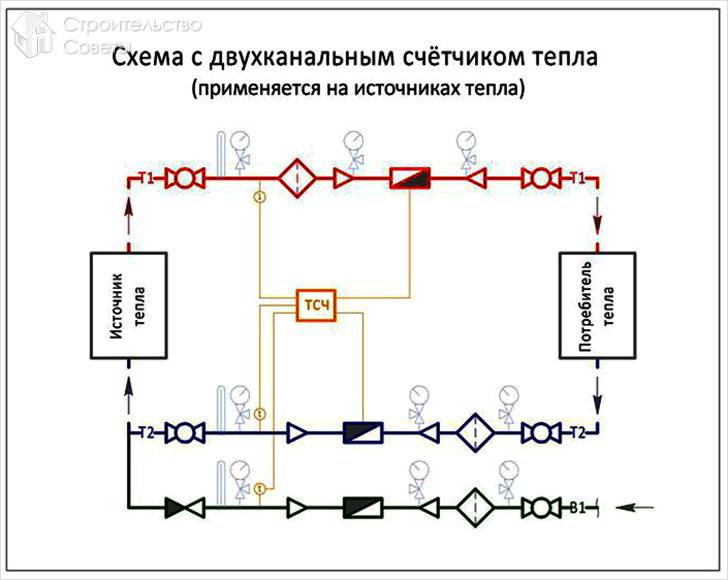


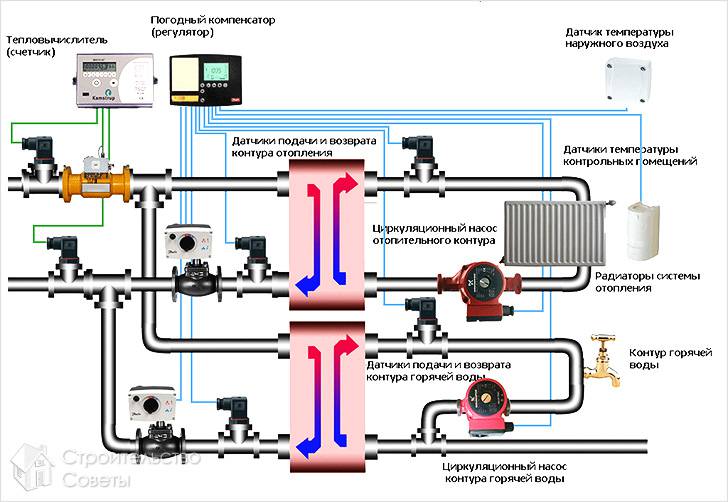
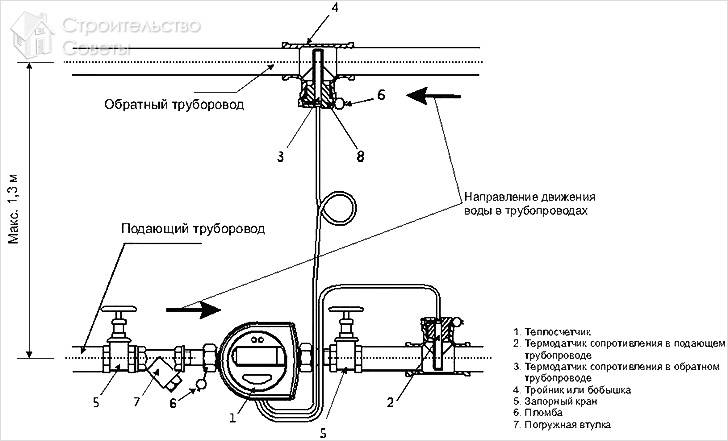
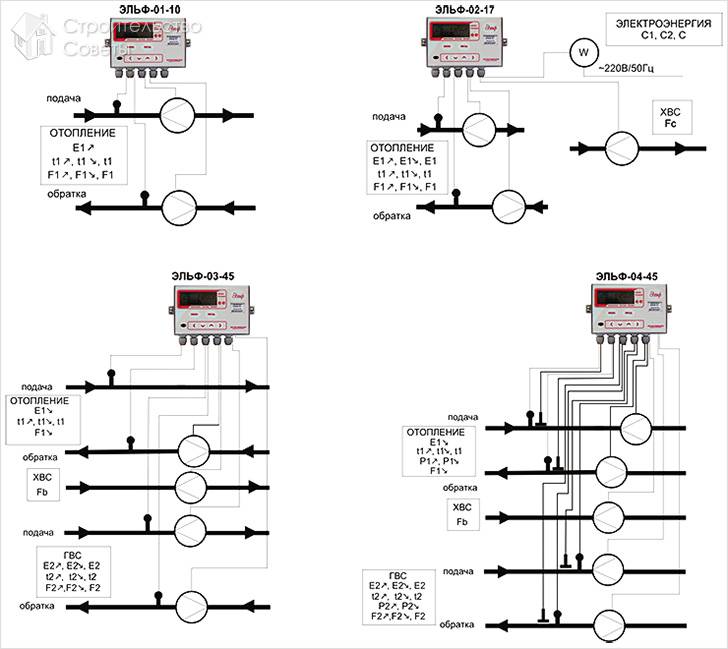
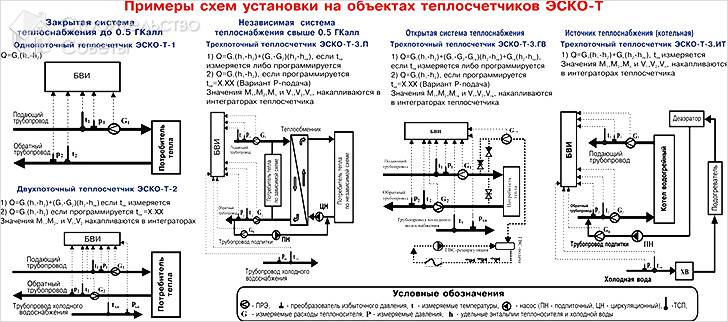
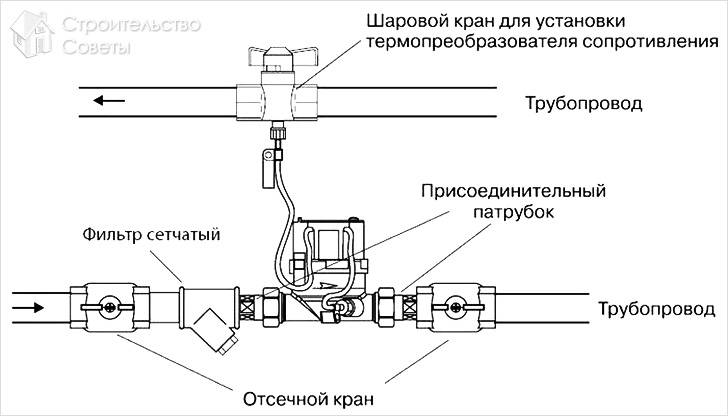

Getting bills for utilities, sometimes throws in a fever. The reason for this is not at all hot radiators in the apartment, but the unfair amount presented for payment. Perhaps you were lucky, and during the heating season the rooms had a pleasant temperature or you, suffocating from the heat, shared the warmth with environment. But it may also be that there were clearly not enough degrees of heat and it was necessary to insulate additionally, but, nevertheless, the discomfort in no way affected the amount in the receipt.
Indeed, if the receipt reflects the figures according to the readings of the house heat meter, without taking into account individual heat consumption, the calculations are of a general nature, and the amount is charged based on the availability of square meters.
If you have matured to the decision to install a personal heat meter in an apartment, remember that by itself it will not give an economic effect, but would save on heating within reason, reflecting current consumption. You will notice that the slightest fluctuation in the temperature regime in the direction of decrease will be reflected in the contents of the wallet towards the increase vector.
 The counter allows control consumption in the event that the assembly is performed correctly, and the thermostat controls the temperature. Having lowered the degrees before leaving for work, at the end of the month your rationality will turn into economic bonus. Only a decrease in parameters in 1C to 6% saves thermal energy.
The counter allows control consumption in the event that the assembly is performed correctly, and the thermostat controls the temperature. Having lowered the degrees before leaving for work, at the end of the month your rationality will turn into economic bonus. Only a decrease in parameters in 1C to 6% saves thermal energy.
If you are thinking about installing the device in an apartment, you should know that the procedure is unreasonably complicated, you will need to collect the required list of documents, and prepare for unexpected expenses.
Required documents
The installation process, registration of the meter and collection of documents varies within 6 -8 000 rub. If you want to do the preparation of documents yourself, be patient for a couple of months, visit the relevant authorities, and get:
- Permission from the institution on whose balance sheet the house is located.
- Technical requirements from the balance holder of the building supplying heat.
- The design project of the heat consumption unit, based on the selected device. Ready calculations are additionally coordinated with standard values.
- At this stage, installation should be done according to each figure of the project.
- Conclude an agreement to the main contract with the heat supplier, providing for payment based on the performance of an individual meter.
- Issue an act of delivery of the installation of the unit with a representative of the organization supplying heat, and register the device.
At first glance, the list does not imply any particular difficulties, if not for the obstacles in the form of additional documents for each of the items, and waiting for permits up to 15 days.
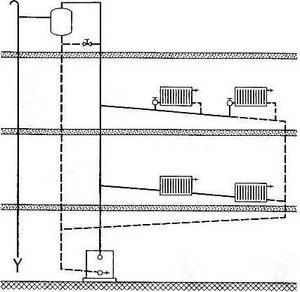 We study the heating system in the apartment. In the case of a one- or two-pipe heating scheme, the topic of installation automatically disappears in the same way as with autonomous heating.
We study the heating system in the apartment. In the case of a one- or two-pipe heating scheme, the topic of installation automatically disappears in the same way as with autonomous heating.
A horizontal heating scheme with a separate floor node is what you should start from.
The location of the apartment is great importance. Hosts corner apartments on the first and last floors you don't have to worry. If for you comfort is indicated by an interval of degrees from 8 to 22C, you will not feel a noticeable difference in budget savings.
Price individual counters fluctuates from 5000 -8000 rub. Modern ultraviolet devices are more expensive, but not always relevant for communal conditions. The vertical contour is due to the attachment of each section to separate riser(two pipes): one comes out from above, the other is directed down.
With a horizontal heating scheme, pipes exit the floor and return there.
In modern buildings, such wiring is usually used, although it costs 20% more expensive previous type. Vertical and horizontal dilution also applies to the water pipeline.
Technical characteristics of the heat meter
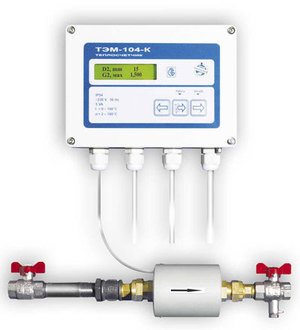 The apartment heat meter is provided for apartments with horizontal wiring pipes. The principle of operation is based on measuring the temperature at the exit and entry into the system and calculating the heat used by means of a coolant.
The apartment heat meter is provided for apartments with horizontal wiring pipes. The principle of operation is based on measuring the temperature at the exit and entry into the system and calculating the heat used by means of a coolant.
Accounting is due to several approaches in fixing expenditure indicators with subsequent processing of the received data.
Modern models have access to computer and the counter values are stored in the device memory up to 10 years old.
The heat meter consists of:
- calculator;
- 3 sensors: 2 temperature and 1 flow meters.
There are calculators with external and autonomous power supply:
- the first type is characterized by a short length of wires and the fragility of batteries (from 6 years);
- the second model requires a 24 V supply, which predetermines the installation of an energy transformer.
Flow sensors are available in 3 types, and determine the model of the heat meter.
Electromagnetic flowmeters
The devices are presented in the form of a compact hydrodynamic generator. Are characterized precision of numbers but they react to the proximity of electrical appliances, and require competent installation. The main disadvantage is the formation of salts on the electrodes that affect measurement accuracy.
Ultrasonic Models
The work is based on the principle of oppositely installed emitters and signal receiver. The exterior is indicated by a hollow pipe section with attached sensors, two thermometers and a heat meter, equipped with an LCD display. It is enough to press the button to read the information.
- the device is informative;
- does not create hydraulic pressure;
- the possibility of remote reading of indicators.
- ultrasonic models, with airy water (bubbles) or in a turbid environment, may display incorrect readings;
- when the power supply is unstable, it requires connection via UPS.
Vane (mechanical) counters
The essence of the work is reduced to the following: in a liquid the turbine is inserted rotating relative to the flow velocity. The device is equipped with a remote signal device that reads the current flow rate.
- democratic price;
- powered by an internal source - batteries;
- ease of operation.
- sensitive to water hammer;
- the turbine, like any mechanism, wears out;
- creates pressure in the system;
- the model is not capable of storing daily information;
- impossibility of remote reading of indicators.
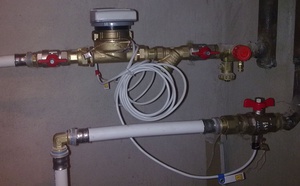 Installing a regulator complete with valves and a board will contribute to even greater savings. If the apartment has high-quality thermal insulation and the temperature is kept within 26 ° C, the regulator is able to adjust the thermal regime to comfortable values \u200b\u200bof 22 ° C, while the counter will count significantly fewer hecto calories.
Installing a regulator complete with valves and a board will contribute to even greater savings. If the apartment has high-quality thermal insulation and the temperature is kept within 26 ° C, the regulator is able to adjust the thermal regime to comfortable values \u200b\u200bof 22 ° C, while the counter will count significantly fewer hecto calories.
The presence of a device in the apartment implies control and regulated supply of heat to radiators using stopcocks. Even with one screwing of the tap (it is forbidden to shut everything off!) There is a noticeable difference in payment.
For example, for 35sq. m. owner pays up to 2000 rubles. With the installation of the counter, you will save a thousand at least. Savings depend on sq. m. of the premises and in the presence of a large footage, the advantage will be obvious.
Choosing an apartment meter
The installation of the appliance is authorized by companies licensed to carry out such work, otherwise the acceptance certificate will not be signed. A specialist from a heat supply organization will help you make the right purchase, competently instructing you about the design characteristics. The requirements are usually:
- to sensors responsible for transmitting indicators at a distance;
- the volume of incoming information, as well as its archiving;
- error values.
The main selection criterion is the coolant and the heat input scheme, while an important role is played by maximum scores, known to specialists of the heat supply company.
There are certain points on the choice of heat meters, due to pipe size system and pipe connection in the device. Usually, the outlets of the meter are smaller than those of the pipes, which provokes an increase in hydraulic pressure in the installation section. This also affects number errors, and in the direction of increasing consumption.
Important defining parameters in the device model are thermal inputs, presence and type of system DHW.
We also mean pressure drops in system. Quite often, the indicator is characterized by a small value.
Installation options
The installation scheme of the structure does not provide for difficulties, and depends solely on its functionality.
- The sensors are installed in the system for supply or return, and are attached to the supply outlet.
- One shut-off valve is installed on each side of the meter.
- It is required to place the filter mesh in the direction of water flow.
After graduation heating season, the owner is obliged to take readings and submit them for agreement with the tariff. The values are removed, as well as from the electric meter: the difference in numbers is multiplied by the tariff.
An inspection is considered a mandatory procedure every 4 years. In the event of a malfunction, the metrologist has permission to dismantle, and sealing after troubleshooting.
The result of all your efforts will be saving material and heating resources. In about a couple of seasons, the investment will pay off, and low amounts in receipts will no longer shock.
2016-09-08 10:43:59
And we were not allowed to install people from the housing and communal services. The reason for the refusal was that we, supposedly, will cheat at home. Well, how is this possible? After all, there is a standard mechanism in the same place and it is impossible, in principle, to cheat something. Now we will complain to higher authorities.
Description:
Real saving of energy resources in housing and communal services can be achieved only when every resident joins the process of energy saving. The best incentive to save money is always a material interest: if you spend less, you pay less. Such a system of calculations can be provided only with the help of individual accounting. Let's consider how the issues of individual accounting of energy resources are solved in Moscow, where in the general complex of measures for energy saving this area is given the most important role.
Individual metering of heat energy consumption
E. V. Inochkin , Head of the Technical Policy Department of the Department of Capital Repairs of the Housing Stock of the City of Moscow
Real saving of energy resources in housing and communal services can be achieved only when every resident joins the process of energy saving. The best incentive to save money is always a material interest: if you spend less, you pay less. Such a system of calculations can be provided only with the help of individual accounting. Let's consider how the issues of individual accounting of energy resources are solved in Moscow, where in the general complex of measures for energy saving this area is given the most important role.
Individual metering of water and electricity has been successfully implemented and has been operating in the capital for many years. Residents have been accustomed to electricity meters since Soviet times, and the benefits of installing water meters became apparent when a charging methodology was adopted at the city level that stimulated the transition to individual devices. Residents who installed meters began to save water and their payments. As a result, within a few years, the specific water consumption in the city per inhabitant entered the civilized framework and became comparable to European indicators.
Thermal energy accounting
The situation is different with individual (ie apartment-by-apartment) heat metering. Only a few multi-apartment buildings (MKD) with a horizontal (apartment-by-apartment) wiring of heating systems, built according to individual projects, can boast of the presence of apartment heat meters.
The main part of the city's housing complex is made up of typical industrial buildings with vertical heating systems, in which several heating risers pass through each apartment. Such houses lack not only heat metering devices, but also the very possibility of saving heat in apartments, because. There are no battery thermostats.
Specialists are well aware that the organization of a modern system for regulating and accounting for heat in MKD is a whole range of activities that includes the following steps:
- installation of an automated metering and control unit at the entrance to the building,
- balancing of heating risers,
- equipping each heater with thermostatic regulators,
- installation of individual metering devices.
In accordance with the regulatory document SP 60.13330.2012 "Heating, ventilation and air conditioning", apartment heat meters in heating systems with horizontal wiring and radiator distributors in systems with vertical wiring are used as apartment heat meters. Such a set of measures requires significant financial costs, which neither the city budget nor the residents themselves can undertake in one fell swoop. However, without such modernization, the introduction of individual heat metering is impossible.
Radiator distributors
A few words about radiator distributors - compact devices that measure the temperature difference between the battery surface and the air in the room.
The device integrates the measured temperature difference over time and calculates the heat transfer value of the heater in proportional units. The conversion factor of the distributor units to Gcal is different for different buildings and different measurement periods. This coefficient must be calculated for each accounting period by distributing among the apartments all the costs of the house, measured by the general house heat meter.
Calculations are made by special software, which contains an algorithm for the distribution of consumed heat in accordance with the current regulatory framework. At the same time, the hotter the batteries in the premises, the greater the value shown by the radiator distributors, and hence the higher the payment for the consumed heat resources. However, the amount of payments for all apartments will always be equal to the payment for the whole house, billed by the heat supplier.
The advantages of radiator distributors are affordable price, ease of installation and maintenance. Distributors serve at least 10 years and during this period do not require intermediate verification.
In Europe, radiator distributors have been widely used since the 1970s and have proven their effectiveness as individual metering devices.
Legal requirements
In Russia, a significant impetus to the introduction of individual heat metering was given by Law No. 261-FZ "On Energy Saving ...", which prescribes the mandatory introduction of all types of individual energy metering, starting from January 1, 2012, in all new construction and, if technically possible, - when building reconstruction.
The construction complex of Moscow has accepted the order of the law for execution, and, starting from 2011, in all projects of newly constructed buildings - both with horizontal and vertical wiring - individual energy metering systems are provided, including individual heat metering.
In reconstruction, the situation is more complicated due to the above-mentioned need for a complete modernization of the heating systems of existing buildings. However, the Moscow government and the Department of Capital Repairs of Moscow are doing everything possible in this direction.
Since the measures to introduce individual regulation and heat metering are expensive, their implementation is carried out in stages. The first step was the city program to install metering stations at the inputs of the heating system of all buildings in the city. The implementation of the program was launched in 2004 in accordance with Decree No. 77-PP of the Moscow government.
Starting from 2008, the complex of measures for the overhaul of apartment buildings included such mandatory elements as the installation of automated control units on the water in buildings and the installation of thermostatic controllers on all heating appliances in apartments. In buildings that have undergone major repairs, in order to complete the modernization of the heating system, in fact, it remains only to install a system of apartment heat metering.
This task is already quite within the power of the residents themselves, because. installation of radiator distributors with visual reading of indications on average for one apartment costs 3-4 thousand rubles. and pays off in 1–2 years with an economical approach to heat consumption.
There are also distributors with automated remote data transmission via radio. Such systems are more expensive - an average of 8-10 thousand rubles. for an apartment. However, their payback periods are also quite foreseeable: 3-4 years, and taking into account the growth of tariffs for thermal energy, they are decreasing.
First pilot project
In order to prepare the city's housing and communal services complex for the introduction of apartment-by-apartment heat metering, in 2010–2011 the Department of Capital Repairs of Moscow implemented the first pilot project to install an individual metering system with automated data collection based on radiator distributors.
Equipment for individual accounting was installed in two residential buildings that underwent major repairs at the address: st. Obrucheva, 53 and 59.
Radiator distributors with a built-in radio module were mounted on each heater, network nodes for data collection were installed on the floors, and house concentrators were installed in the switchboard rooms to transfer heat consumption data to the Ethernet network. The readings of the radiator distributors are transmitted to the data collection server in the GU IS "Cheryomushki" on a daily basis. Since the installation and commissioning of the equipment, heat consumption in apartments has been monitored.
The calculation of heat consumption by each apartment according to the readings of radiator distributors 1 and the transfer of the results to the ACS EIRTs database is carried out using special software provided by the manufacturer of the accounting system.
The results of the pilot project show that heat accounting and economical behavior of residents have a very noticeable effect on their heating costs: the payment for "economical" and "wasteful" apartments in terms of 1 m 2 of area differs by 2-3 times.
In monetary terms, savings in apartments amounted to 3–6 thousand rubles. at a cost of 1 Gcal 1324 rubles. in 2011.
Currently, the EIRC software is being finalized to fully automate the calculation procedure.
Barriers to mass adoption
However, for the mass introduction of apartment heat metering in the existing housing stock, there is still not enough.
First, as noted above, a comprehensive modernization of the heating systems of old buildings with the installation of modern control equipment is necessary.
In European countries, since the 1970s, legislation has been adopted that promotes the massive modernization of building heating systems using individual regulation and heat metering. In most of these countries, state support programs have been implemented for homeowners and management companies carrying out such modernization, providing for the reimbursement of part of the necessary funds from targeted state funds, repayment of interest on loans, and other incentives and incentives. Comprehensive modernization was carried out in stages, while support measures taken at the state level made it accessible to all residents.
There are no such programs in Moscow, and the absence of affordable targeted lending schemes for energy-saving measures does not allow either residents or energy service companies to raise funds for the necessary equipment and installation work.
Another important factor is the lack of incentive for management companies (MCs) to introduce individual heat metering.
Installation and maintenance of apartment heat metering systems for management companies is an additional heavy burden that does not bring any income. It would seem that those management companies that offer apartment heat metering services to residents have competitive advantages in the housing management market. However, there is no real competition in this market. Residents don't really have a choice maintenance your home and accounting for energy resources.
Changes are needed in the regulatory framework in the field of activity of management companies, which would allow them to recoup their costs and receive profit (or other benefits) from the provision of services for the organization and maintenance of apartment heat metering.
The practice of applying the federal regulatory framework in terms of individual accounting revealed a number of inconsistencies between the requirements of Law No. 261-FZ and RF Government Decree No. 354 (PP No. 354).
Thus, Law No. 261-FZ prescribes the installation of individual metering devices in all newly constructed buildings. However, most of the typical mass construction is focused on vertical piping of heating systems. In such buildings, as noted above, in accordance with SP 60.13330.2012, radiator distributors should be installed for apartment heat metering. There is simply no other solution for vertical systems.
But from the terms used in PP No. 354, it can be concluded that radiator distributors do not fall under the definition of “individual metering device” - despite the fact that, in fact, radiator distributors successfully perform all the functions of an individual metering device.
This inconsistency causes attempts by some construction companies to abandon the use of distributors for individual accounting. Thus, millions of residents of typical vertically distributed multi-family buildings may lose the opportunity to save on heating bills and lose the incentive to save heat.
To resolve this contradiction, it is necessary to introduce the concept of “individual accounting system” into the legislation, which should consist of the following components:
- a common house heat energy meter for heating,
- apartment appliances, the readings of which should directly depend on the actual heat consumption of each apartment.
Apartment devices can be apartment heat meters, radiator distributors or any other means of measuring energy resources. Such a definition of an individual heat metering system will make it possible to select a technically correct set of equipment for any heating systems in a building and provide an incentive for energy saving for end consumers.
In addition, those parts of PP No. 354 that describe the procedure for calculating consumer payments based on the testimony of distributors do not contain detailed instructions for calculating in some non-standard cases. This causes difficulties in the organization of calculations for distributors.
In addition to PP No. 354, there is another regulatory document - Methodology MDK 4-07.2004 "Methodology for the distribution of general house consumption of heat energy for heating between individual consumers based on indications of apartment heat metering", approved by the State Construction Committee of the Russian Federation in 2004 and describing in detail the algorithm for calculating individual consumption. However, for the mass introduction of individual accounting, a document of a higher status is required.
Thus, the implementation of the provisions of Law No. 261-FZ in terms of individual metering of heat energy, as well as the opening of a road for individual metering in the existing housing stock, requires further joint action on the part of legislative and executive bodies. I would like to hope that the economical use of heat in residential buildings will become the same norm for residents, as happened with electricity and water. This will reduce the monthly expenses of Moscow families and save energy resources for future generations.
1 In accordance with Decree of the Government of the Russian Federation of May 6, 2011 No. 354 “On the provision of public services to owners and users of premises in apartment buildings and residential buildings”.

